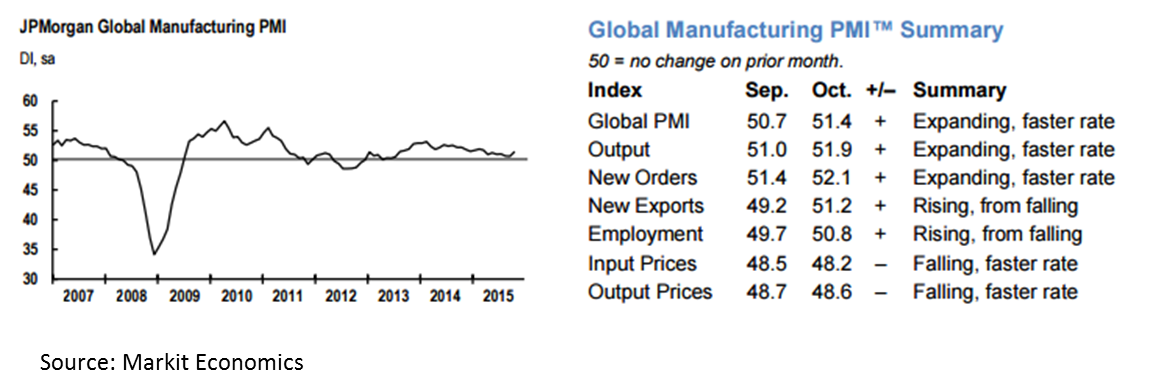Economy

Global Manufacturing Declines in Asia but Improves in EU and NA
Written by Sandy Williams
November 3, 2015
The J.P. Morgan Global Manufacturing PMI indicated manufacturing is expanding at a slightly faster rate as the world enters fourth quarter. The October Global PMI registered at 51.4, up from 50.7. The UK led the rise in manufacturing with solid improvement in output and new orders. The U.S. took second place in manufacturing growth alongside a surprisingly robust Italy. Expansion was noted in most of the Eurozone while emerging markets remained in recession for the seventh month.
Input costs and output charges continued to fall and at a faster rate in October. The sharpest decreases were seen in developed markets, while pricing in emerging nations stayed relatively unchanged.
North America
The Markit U.S. Manufacturing PMI jumped to 54.1 from 53.1 in September on faster rises in output, new orders, and employment levels. Pre-production inventory destocking continued for the third month. Manufacturers benefited from falling commodity prices, including steel and other metals.
Canadian manufacturers experienced another downturn in manufacturing conditions with production output fell at a steep rate. New orders continued to decline and new export orders decreased for the first time since April. The RBC PMI posted at 48.0, down from 48.6 in September and in contraction for the third month in a row.
The Mexico Manufacturing PMI reached its highest level since May, posting 53.0 from a reading of 52.1 in September. Production volumes were up and new orders rose despite a slowdown in export order growth. Job creation in the manufacturing sector hit a three-year high which in turn contributed to a reduction in backlogs or work. “A robust and accelerated rise in new business levels was achieved in spite of another slowdown in export sales growth, suggesting that resilient domestic demand has helped to soften the impact of weaker global trade volumes in recent months,” commented, Tim Moore, senior economist at Markit.
Eurozone
The Eurozone PMI improved slightly to 52.3 in October from 52.0 in September. Manufacturing growth at the beginning of fourth quarter was still considered tepid but in line with the third quarter growth rate. Greece remains in severe contraction but showing an easing in the rate of contraction. Eurozone export orders had the largest gain in four months. “The Eurozone manufacturing recovery remains disappointingly insipid, “said Chris Williamson, Chief Economist at Markit. ‘With factory production lacking vigour, employment growth sagging to an eight-month low and output prices falling at the fastest rate since February, it’s easy to see why the ECB are considering additional stimulus.”
Asia
Manufacturers in China saw business continue to deteriorate in October, but at a slower pace. The PMI registered 48.3 in October, up from 47.2 in September. Continued softening in domestic demand contributed to a marginal increase in exports. Firms cut back on production and purchasing activity during the month leading to further reduction in inventories. Stocks of finished goods increased as sales fell. Input costs and output prices declined at a steeper rate. Survey panelists linked lower input prices to cheaper raw material, in particular, metals. Input costs savings resulted in lower selling prices designed to attract customers.
Commenting on the China General Manufacturing PMI™ data, Dr. He Fan, Chief Economist at Caixin Insight Group said: “The Caixin China General Manufacturing PMI for October is 48.3, up 1.1 points from the reading for September. The slight upswing shows the manufacturing industry’s overall weakening has slowed down, indicating that previous stimulating measures have begun to take effect. Weak aggregate demand remained the biggest obstacle to economic growth, and the risk of deflation resulting from the continued fall in the prices of bulk commodities needs attention.”
Japan manufacturing surged to an eight month high, posting 52.4 from 51.0 in September. Production and new orders showed marked increase due to new product introduction and greater demand domestically and abroad.
South Korea fared less well in October, remaining in contraction at 49.1. Survey respondents cited poor demand due to challenging global economic conditions. A modest decline was seen in new orders at home and abroad.
Manufacturing stabilized somewhat in Vietnam in October due to a slight uptick in production. Although output increased, new orders were down slightly and new export orders contracted for the fifth consecutive month. The Vietnam Manufacturing PMI registered 50.1, up from 49.5 in September.
Russia
Manufacturing in Russia pulled out of contraction in October to a PMI of 50.2, up from 49.1 in September. New orders increased modestly on stronger domestic demand. Export orders continued to decline. Purchasing activity fell in October and along with it pre-production inventory. Output charges and input costs both climbed and were partially offset by easing rates of inflation.
Paul Smith, Senior Economist at Markit commented, “The headline PMI finally broke through the 50.0 no-change barrier in October and thereby marking an important step in the ongoing recovery of the manufacturing sector following the turbulence seen earlier in the year. Domestic demand is the principal driver of the expansion, with total new orders rising at the best rate for nearly a year. That’s in spite of the sharpest fall in new export orders for three months.”

Sandy Williams
Read more from Sandy WilliamsLatest in Economy

Steel groups welcome passage of budget bill
Steel trade groups praised the passage of the Big Beautiful Bill (BBB) in Congress on Thursday.

Industry groups praise Senate for passing tax and budget bill
The Steel Manufacturers Association and the American Iron and Steel Institute applauded the tax provisions included in the Senate's tax and budget reconciliation bill.

Chicago PMI dips 0.1 points in June
The Chicago Purchasing Managers Index (PMI) slipped 0.1 points to 40.4 points, in June.

Multi-family pullback drives housing starts to 5-year low in May
US housing starts tumbled in May to a five-year low, according to figures recently released by the US Census Bureau.

Architecture firms still struggling, ABI data shows
Architecture firms reported a modest improvement in billings through May, yet business conditions remained soft, according to the latest Architecture Billings Index (ABI) release from the American Institute of Architects (AIA) and Deltek.

